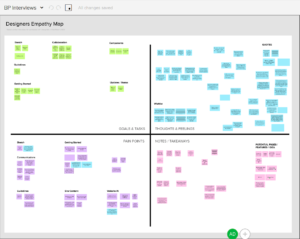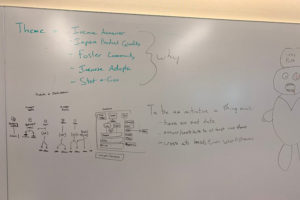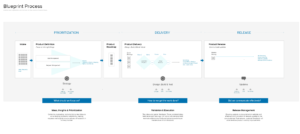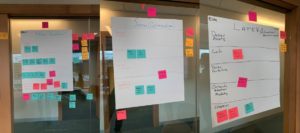– My roleS: Content and UX strategist –
Challenge
The Blueprint Design System team had been working on the nuts and bolts for over a year. They’d designed components, the system’s visual language, and code. They had a solid first release.
They were also overwhelmed.
The team lacked a strategic plan for maturing Blueprint based on designers’ daily needs.
Designers were reluctant to use the system, instead recreating components project by project.
I knew the Blueprint team needed structure and clear communication to build trust among designers.
Approach
I worked with Blueprint’s Product Owner and a Design System Lead to understand the maturity of the system’s:
- code
- visual design assets (as expressed in a packaged Sketch library)
- documentation
- intake process for adding components
We used design thinking methods like What’s on your radar? and the Importance/Difficulty Matrix to expose information and the vision held by the Product Owner.
His ideas Blueprint’s potential for impact needed to be systematized into a plan.
We worked together to get consensus on where the team could make updates, focusing on immediate impact. And we wanted to understand longer term strategic challenges.
Understanding Users

The Design Lead and I interviewed designers in Fannie Mae’s Customer Experience Design (CXD) group.
We discovered a major gap in designers’ understanding of Blueprint’s purpose and their role in the system.
Designers saw Blueprint as one more roadblock to interacting with their product teams.
Inconsistent release schedules and lack of insight into the Blueprint team’s work created distrust.
Our key takeaway: The Blueprint team’s plans needed to tell the story of the design system’s value clearly.
Drilling down to governance
We focused how the Blueprint team’s tactical work contributed to the strategic whys of a mature design system. Expressed as themes, we could tie advancing the design system to partners’ priorities for Fannie Mae.

We also hooked each theme to CXD’s internal goals.
We hoped this would clarify the ways in which Blueprint was more than just a enabler of implementation teams.
We wanted leadership to understand Blueprint could be a vehicle for changing the design culture inside both CXD and Fannie Mae.

We saw being able to communicate this process with details as vital to rebuilding trust in the design system with CXD’s designers.
Strategic Plan
We tackled the design system maturity roadmap next.
Our point of view: tactical implementation was fine. Without an idea of long-term impact, senior leadership would still view the design system as a risk.

Several days and many pads of stickies later, we had an idea of how to communicate our vision for maturing the design system

I translated these intensive sessions into a Mural-based based presentation.
This level of detail – strong in the now and more fuzzy as we looked to the future – allowed us to tailor the presentation of this complex plan our audience’s attention span.
The goal was to convince CXD’s leadership team – three design directors, an operations director, and vice president – to allow designers to actively participate in co-creating the Blueprint Design System.
We also wanted to demonstrate the team understood this wasn’t just a design exercise: Blueprint needed to show real value for the enterprise.
Results
Our senior leadership endorsed the phased maturity plan.
They embraced the idea that “now” is more certain and the future would come into view as we grew understanding, adoption, and usage across the enterprise.
They provided feedback that we focus on measurable impacts (e.g. staff hours saved) as a criterion for moving Blueprint from one phase to the next instead of on time as the deciding factor.
The leadership team praised our intentions and spirit of the approach.
CXD faced funding and financial pressures that prevented designers from devoting even 1-2 hours per week to co-creating the design system.
Maturing the design system was left to a small core team primarily focused on tactical delivery.
I was a member of that core team from mid-2019 through March 2021. We were able gain wider adoption with business unit partners by:
- improving Blueprint’s documentation
- designing and delivering training to educate on the importance of UX, content design best practices, and how Blueprint could save them time and money